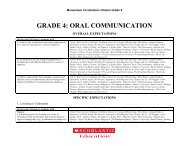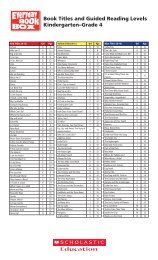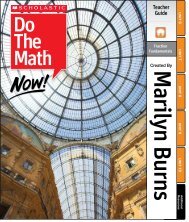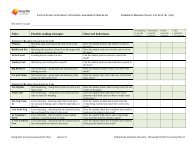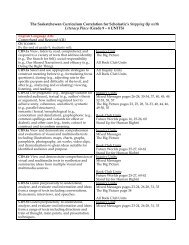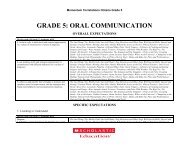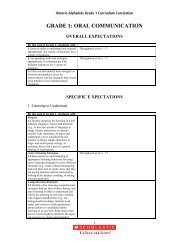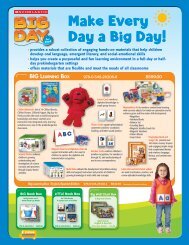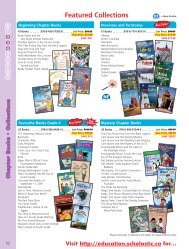FROM MaRilyn BuRns - Scholastic
FROM MaRilyn BuRns - Scholastic
FROM MaRilyn BuRns - Scholastic
Create successful ePaper yourself
Turn your PDF publications into a flip-book with our unique Google optimized e-Paper software.
TMCreated byMarilyn Burns<strong>FROM</strong> <strong>MaRilyn</strong> <strong>BuRns</strong>in lessons 1–5,students…• Use the benchmark of 5 torepresent sums of 6 to 9.• Identify pairs of addendswith sums to 9.• Communicate ideas withkey math vocabulary: add,addend, addition, equals,equation, plus, and sum.Dear Colleague,This module has been specifically designed for students who lack afoundation in the very basics. The number 5 is an important benchmark inour base-ten number system, and the first two lessons ease students into themodule with a focus on pairs of addends that make 5.Students use two-color counters as a visual tool. They engage in twoactivities—Shake and Spill and Race to the Top. A variety of games andactivities like these are woven throughout the module to motivate students’interest and support their learning. In these first two activities, students spillfive counters to generate pairs of addends that make 5 and then record thedifferent combinations.Students are then introduced to another visual tool—theten-frame. The ten-frame is ideal for providing a structurethat helps students use the benchmark number of 5 to buildnumbers and find sums to 10. The strategy of making a 5is useful for building students’ number sense and skill withsums to 10.Students use the ten-frames along with the two-color counters for a newactivity—Roll and Add—which gives them practice figuring sums to 10.Students also revisit Shake and Spill and Race to the Top, now applying theseactivities to numbers greater than 5. They also investigate patterns in pairs ofaddends for sums to 10.The number 5 is animportant benchmark inour base-ten numbersystem.Lessons1–5The Benchmark of 5Addition & Subtraction Number CoreTeacher GuideLetter: Lessons 1–52The Benchmark of 5DTM_NC_TG_001-005.indd 22/16/11 4:14 PMDTM_NC_TG_001-005.indd 3Addition & Subtraction: Number Core2/10/11 12:46 PMReduced Teacher Guide, pages 2–3
TMCreated byMarilyn BurnsPLANNERLesson SummaryLesson 1 Lesson 2Students use use two-color counters to toStudents find find and and list list all pairs all pairs of ofgenerate pairs pairs of of addends that that make makeaddends that that make make 5 and 5 and then then play play5 and 5 and then then write write them them as as equations a game a game to practice to practice making making 5. 5.with with addition.Lesson 3 Lesson 4 Lesson 5Progress MonitoringStudents use use a a ten-frame and and the theStudents use use the the benchmark of 5 of 5Assessment ✓Progress Monitoringbenchmark of 5 of to 5 build to build numbers to to represent sums sums of 6 of to 610.to 10.Students demonstrate understandingand and find find sums sums to 10. to 10.of the of the objectives of Lessons of Lessons 1–4 1–4by by completing a a WorkSpace page pageindependently.Objectives • Identify • Identify pairs pairs of addends of addends that that make make 5. 5.MaterialsT Teacher Teacher Bag BagS Student Student Bag BagAll hands-on All hands-on manipulatives and and WorkSpacepages pages are provided are provided on the on the InteractiveWhiteboard Tools Tools CD-ROM. CD-ROM.Built-inDifferentiation• Introduce • Introduce key key math math vocabulary: add, add,addend, addend, addition, addition, equals, equals, equation, equation,plus, plus, and and sum. sum.• • WorkSpace pages pages 2, 64, 2, and 64, and 66 66• • two-color counters counters S T• plastic • plastic cups cups S T• chart • chart paper paperTeaching Number Senseby Susan Scharton,pages 62–71• Identify • Identify all possible all possible pairs pairs of addends of addendsthat that make make 5. 5.• Given • Given a number, a number, figure figure how how many many more moreto make to make 5. 5.• • Communicate ideas ideas with with key key math mathvocabulary: add, add, addend, addend, addition, addition,equals, equals, equation, equation, plus, plus, and and sum. sum.• • WorkSpace pages pages 2–5 2–5• • two-color counters counters S T• plastic • plastic cups cups S T• red • red and and yellow yellow whiteboard markers markersUsing Using a a hands-on color color counters—to represent various various pairs pairs of addends of addends that that make make 5 promotes 5 promotesmanipulative—two-Playing Playing a game a game in pairs in pairs to identify to identifypairs pairs of addends of addends with with the same the same sum sum helps helpscommunication and and mathematicalstudents students connect connect a concrete a concrete experiencelanguage among among students. students.with with a more a more abstract abstract experience of writing of writingequations.• Identify • Identify numbers numbers to 10 to using 10 using the thebenchmark of 5. of 5.• Use • Use the the benchmark of 5 of to 5 torepresent sums sums of 6 of to 610.to 10.• Use • Use the the benchmark of 5 of to 5 to representsums sums of 6 of to 610.to 10.• • Communicate ideas ideas with with key key math math • • Communicate ideas ideas with with key key math math • Identify • Identify pairs pairs of addends of addends with with sums sumsvocabulary: add, add, addend, addend, addition, addition,equals, equals, equation, equation, plus, plus, and and sum. sum.vocabulary: add, add, addend, addend, addition, addition,equals, equals, equation, equation, plus, plus, and and sum. sum.to 9. to 9.• • Communicate ideas ideas with with key key math mathvocabulary: add, add, addend, addend, addition, addition,equals, equals, equation, equation, plus, plus, and and sum. sum.• • WorkSpace pages pages 6 and 6 and 7 7• • ten-frames S T• • two-color counters counters S T• yellow • yellow crayons crayons• • WorkSpace page page 8 8• • ten-frames S T• • two-color counters counters S T• red • red and and yellow yellow number numbercubes cubes (0–5) (0–5) S T• Do • The Do The Math Math Community News NewsThe The visual visual representation of counters of counters Using Using manipulatives, such such as ason a on a ten-frame focuses focuses students students on onten-frames, helps helps students students use use the thethe the benchmarks of 5 of and 5 and 10 thus 10, thusbenchmark of 5 of to 5 name to name numbers numbersenabling enabling them them to to compose, decompose, without without counting counting by ones. by ones.and and add add numbers numbers flexibly. flexibly.TeacherSpace : Addition & SubtractionCD-ROM contains videos, professional articles,and reproducibles to support teaching theselessons.• • WorkSpace pages pages 9 and 9 and 10 10• • ten-frames S T• • two-color counters counters S TAssessing with with visual visual models models and andsymbolic representations allows allowsstudents students to show to show their their understandingwithout without having having to approach to approach the material the materialin an in an unfamiliar format. format.Lessons1–5The Benchmark of 5Addition & Subtraction Number CoreTeacher GuidePlanner: Lessons 1–54The Benchmark of 5DTM_NC_TG_001-005.indd 42/10/11 12:47 PMDTM_NC_TG_001-005.indd 52/16/11 4:14 PMAddition & Subtraction: Number CoreReduced Teacher Guide, pages 4–5
TMCreated byMarilyn BurnsLesson3 Using 5 as a benchmarkPrevious Lesson Students play agame finding pairs of addends that make 5.Lesson 3 Students use a ten-frameand the benchmark of 5 to build numbersand find sums to 10.Next Lesson Students use the benchmarkof 5 to represent sums of 6 to 10.Lesson SummaryStudents use a ten-frame and the benchmarkof 5 to build numbers and find sums to 10.Objectives• Identify numbers to 10 using the benchmarkof 5.• Communicate ideas with key math vocabulary:add, addend, addition, equals, equation, plus,and sum.Materials• WorkSpace pages 6 and 7• ten-frames S T• two-color counters S T• yellow crayons Teacher Bag Student BagInteractive Whiteboard ToolsWorkSpace pages and manipulatives for Lesson 3 areprovided on the Interactive Whiteboard Tools CD-ROM.Language DevelopmentKey Math VocabularyENGLISHaddaddendadditionequalsequationplussumAcademic VocabularyENGLISHrowCognates are shown in italics.SPANISHsumarsumandoadiciónes igual aecuaciónmássumaSPANISHfilawhoLe groupStep1Introduce the ten-frame.1 Introduce the lesson.We / have added numbers to make 5. Today we willbuild numbers to 10.2 Introduce the ten-frame.Show students a ten-frame.This / is called a ten-frame.Slide your finger across each row as you ask thefollowing questions.How / many rows are there in this frame? (2)How many boxes are in each row? (5)How many boxes are there in all? (10)I will show you how we place counters on the ten-frame.Place 5 two-color counters, one at a time, red side up, onthe ten-frame. Start at the top row with the box on thefar left. Have students count with you as you place eachcounter in the top row—1, 2, 3, 4, 5.When / the top row of the ten-frame is full, you knowthat there are 5 counters, so you don’t have to countthem one-by-one.3 Continue to place counters onthe ten-frame.I start / the next row by placing a red at the left.Continue placing the counters red side up one at atime from left to right until the ten-frame is filled.Have students count with you as you place eachcounter—6, 7, 8, 9, 10.How / many counters are on the ten-frame whenit’s full? (10)Remove the counters from the bottom row.How / many counters are there now? (5)If one row is full, we know there are 5 counters.If both rows are full, we know there are 10. Wedon’t have to count them one-by-one.Step2whole groupGuide students tobuild on from 5.1 Use the benchmark of 5 to buildnumbers on the ten-frame./I will place one more counter on the ten-frame.Place one counter yellow side up on theten-frame.Sweep your hand across the top row as you sayfive and then point to the one yellow as you saysix.Start / with 5 and count on 1 to get 6. I don’t haveto count the 5 because I know there are 5 countersin the top row.Place another counter yellow side up on theten-frame.How / many counters are on the ten-frame now? (7)Yes, there are 7 counters. I start with 5 and counton two more to get 7. Five…six, seven.Continue this process for 8 and 9 counters. Besure to count with students, sweeping your handacross the top row and then pointing as you counton: five…six, seven, eight and five…six, seven,eight, nine.Place the tenth counter on the ten-frame.How / many counters are on the ten-frame now? (10)Remember we don’t need to count one-by-onewhen the ten-frame is full.Addition & Subtraction Number CoreTeacher GuideLesson 3Continue14The Benchmark of 5Lesson 315DTM_NC_TG_014-017_L3.indd 142/9/11 12:52 PMDTM_NC_TG_014-017_L3.indd 152/9/11 12:52 PMAddition & Subtraction: Number CoreReduced Teacher Guide, pages 14–15
TM1 2Write an equationfor colors.Write an equationfor rows.Home Note: Your child writes equations with sums to 9.Lesson 5Created byMarilyn BurnsLesson5 Assessing student understandingPrevious Lesson Students usethe benchmark of 5 to represent sumsof 6 to 10.Lesson 5 Students demonstrateunderstanding of the objectives ofLessons 1–4.Next Lesson Students write equations forproblems with a sum of 10 and then identifythe missing addend.Lesson SummaryStudents demonstrate understanding of theobjectives of Lessons 1–4 by completing aWorkSpace page independently.Objectives• Use the benchmark of 5 to represent sumsof 6 to 10.• Identify pairs of addends with sums to 9.• Communicate ideas with key math vocabulary:add, addend, addition, equals, equation, plus,and sum.Materials• WorkSpace pages 9 and 10• ten-frames S T• two-color counters S T Teacher Bag Student BagInteractive Whiteboard ToolsWorkSpace pages and manipulatives for Lesson 5 areprovided on the Interactive Whiteboard Tools CD-ROM.Language DevelopmentKey Math VocabularyENGLISHaddaddendadditionequalsequationplussumAcademic VocabularyENGLISHrowCognates are shown in italics.SPANISHsumarsumandoadiciónes igual aecuaciónmássumaSPANISHfilaStep1whoLe group1 Introduce the lesson.Students use thebenchmark of 5 to add.Today, / we’ll write two equations for sums of 7, 8, and 9.Then you will show me how much you know about using5 to help you add numbers with sums to 9. When you havefinished, if you have time, you can play Shake and Spill for7, 8, and 9 counters.2 Write two equations for a sum of 9.First / let’s add 2 plus 7. On your ten-frame place 2 reds andthen 7 yellows.Check to be sure students do this correctly.If we / look at the colors, we see the addition problem2 + 7. If we look at the rows, we see the addition problem5 + 4. Use the five counters in the first row to help youfind the sum of 2 + 7. (9)We can write two equations. Looking at the colors, wewrite 2 + 7 = 9. Looking at the rows, we write 5 + 4 = 9.Write the equations on the board.2 + 7 = 95 + 4 = 9Point to each equation as you say:Both / 2 + 7 and 5 + 4 are equal to 9.Step2whole groupStudents use thebenchmark of 5to add.1 Write two equations for a sum of 8.Write 6 + 2 on the board.2 + 7 = 95 + 4 = 96 + 2Place / counters on your ten-frame to show thisaddition problem.Use / the first row of 5 to help you figure out theanswer. What did you get? (8) What equationscan you write? (6 + 2 = 8 and 5 + 3 = 8)Write the equations on the board.2 + 7 = 95 + 4 = 96 + 2 = 85 + 3 = 8Supporting inStructionSince this is the first written assessment, explainto students that the purpose of the assessment isto let you know what they have learned and whatmore they need to learn. Explain that although weusually encourage them to work together, for theassessments they will work by themselves withoutconferring with a partner.individualsStudents completean assessment.Step31 Explain the directions for WorkSpacepage 9.Have students turn to WorkSpace page 9. Explainthe directions.Usually / you work with a partner, but for this pageyou’ll work by yourself so that I know what you’velearned and what you still need to learn.2 Students complete WorkSpace page 9.TM & © <strong>Scholastic</strong> Inc. All rights reserved.Show What You KnowDIRECTIONS1 8 95 4 9Equations3 5 81 25 3 82 5 73 45 2 74 5 95 65 4 91 5 67 85 1 63 6 99 105 4 92 6 811 125 3 8Equations7 2 95 4 96 3 95 4 92 4 65 1 68 1 95 4 94 4 85 3 82 7 95 4 99When / you finish page 9, you may play Shakeand Spill for 7, 8, or 9 counters. Use WorkSpacepage 10 to write your equations.Supporting inStructionGive students as much time as they need tocomplete the assessment page. Some students maywant to rush through the assessment so that theycan play the game, especially if they see othersplaying. Assure students that they will get sometime in the following week to play the game if theydon’t get to do it today.Addition & Subtraction Number CoreTeacher GuideLesson 5After the lesson22The Benchmark of 5Lesson 523DTM_NC_TG_022-024_L5.indd 222/9/11 1:05 PMDTM_NC_TG_022-024_L5.indd 232/9/11 1:05 PMAddition & Subtraction: Number CoreReduced Teacher Guide, pages 22–23
TM1 2Write an equationfor colors.Write an equationfor rows.Home Note: Your child writes equations with sums to 9.Lesson 5Created byMarilyn BurnsLesson5AssessmentcontinuedAssessing student understanding✓ Progress MonitoringShow What You KnowAssessUse the annotated page to correct WorkSpace page 9.TM & © <strong>Scholastic</strong> Inc. All rights reserved.Objectives• Use the benchmark of 5 to represent sums of 6 to 9.• Identify pairs of addends with sums to 9.• Communicate ideas with key math vocabulary: add,addend, addition, equals, equation, plus, and sum.Show What You KnowDIRECTIONS1 8 95 4 9Equations3 5 81 25 3 82 5 73 45 2 74 5 95 65 4 91 5 67 85 1 63 6 99 105 4 92 6 811 125 3 8Equations7 2 95 4 96 3 95 4 92 4 65 1 68 1 95 4 94 4 85 3 82 7 95 4 924 The Benchmark of 59Note the progress of each student in the appropriaterows of the tracking chart on page 151.Evaluating Your Students After the FirstAssessmentYou may find that a student is not successful afterthese five lessons are assessed. Use the InterviewAssessment questions found on page 143 toevaluate whether the student will need additionalguidance before moving on to Lesson 6. Theresources on page 144 provide additional waysto support student learning.Differentiating InstructionAlthough the lessons are carefully scaffolded andpaced at a rate to give students a chance for optimallearning, there will be instances when students arestill struggling and need extra support. Also, therewill be instances when students would benefit fromadditional challenges or practice. Try the teachingideas below.For Students Who Need More Support• As students complete the WorkSpace page, observe them toidentify students who count all counters on a ten-frame, oneby one, to get the answer. If you see a student doing this,model for the student how to count on from 5, sweepingyour finger above the top row of 5 counters in the ten-frame,and then counting on the remaining counters, one by one,to get the sum—e.g., 5…6, 7, 8. Have the student repeat,sweeping and counting. Ask him or her to do the same forother numbers of counters on the ten-frame until you aresure he or she can use the benchmark of 5 in this way.• Play Shake and Spill with the student. This will let you guidethe student to place counters correctly on the ten-frame,determine the sum using the benchmark of 5, and write theaddition equations.For Students Ready for a Challenge• Have students play Shake and Spill with 10 counters. Thiswill prepare them for the next section of lessons—findingpairs of addends that make 10.TM & © <strong>Scholastic</strong> Inc. All rights reserved.directions1 21 1 8 5 9Write an equationfor colors.5 1 4 5 9Write an equationfor rows.Home Note: Your child writes equations with sums to 9.Equations1 23 45 67 89 1011 12EquationsLesson 59Addition & Subtraction Number CoreAnnotated WorkSpaceLesson 5DTM_NC_WS_L05_009-010.indd 92/7/11 3:31 PMDTM_NC_TG_022-024_L5.indd 24Addition & Subtraction: Number CoreAnnotated WorkSpace, page 242/16/11 4:11 PMAddition & Subtraction: Number CoreAnnotated WorkSpace, page 9





